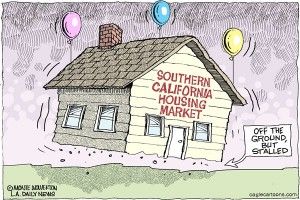Housing report by Legislative Analyst raises affordability questions
 The California Legislative Analyst’s new report on housing costs puts numbers to what housing-hunters know on the ground: affordable housing in the state’s coastal areas is scarce and getting scarcer. But the report itself raises new questions. According to the report, “California’s High Housing Costs: Causes and Consequences”:
The California Legislative Analyst’s new report on housing costs puts numbers to what housing-hunters know on the ground: affordable housing in the state’s coastal areas is scarce and getting scarcer. But the report itself raises new questions. According to the report, “California’s High Housing Costs: Causes and Consequences”:
“Today, an average California home costs $440,000, about two-and-a-half times the average national home price ($180,000). Also, California’s average monthly rent is about $1,240, 50 percent higher than the rest of the country ($840 per month).
“California is a desirable place to live. Yet not enough housing exists in the state’s major coastal communities to accommodate all of the households that want to live there.
“Households with low incomes, in particular, spend much more of their income on housing. High home prices here also push homeownership out of reach for many. … The state’s high housing costs make California a less attractive place to call home, making it more difficult for companies to hire and retain qualified employees, likely preventing the state’s economy from meeting its full potential.”
The LAO prescribed two cures for high-cost housing in already dense coastal areas where frequent environmental opposition to new housing is most rampant.
Higher densities
First, the LAO called for much higher building densities in coastal metropolitan areas, including:
- More than doubling of single family home densities in Los Angeles, Alameda, San Mateo and Santa Clara counties from 4 units per acre to up to 9 units (Figure 10, LAO Report);
- More than doubling townhome and condominium densities in San Francisco from 18 units per acre to 35 to 40 units (Figure 10, LAO Report);
- Building 100,000 additional housing units along the coast each year. This would be the equivalent to building a new city along the coastline with a population of 300,000, or about the size of Riverside or Stockton — each year.
CEQA exemption
Second, the LAO recommends exempting new housing construction from lawsuits under the California Environmental Quality Act for reasons of reduction in traffic congestion and the avoidance of blocked views from “Not-In-My-Backyard” (NIMBY) lawsuits. The LAO report did acknowledge, “CEQA’s complicated procedural requirements give development opponents significant opportunities to continue challenging housing projects after local governments have approved them.” However, the LAO did not bring up the 2013 reforms of CEQA in Senate Bill 743, by then-Senate President Pro Tem Darrell Steinberg, D-Sacramento, for infill development in high-density transit development zones. SB743 eliminated traditional “auto delay” and “level of service” measures of traffic congestion, as well as any parking impacts, as a basis for determining significant impacts of infill housing development under CEQA. The provisions of SB743 will not become effective until sometime in 2016. The California Infill Building Association, the California Teamsters Public Affairs Council, and the Sacramento County Board of Supervisors, which was seeking relaxation of CEQA for a sports stadium project, supported SB743. Opposition to SB743 came from the Planning and Conservation League and the Sierra Club. SB743 should help a little with the constructing new dwellings.
Home rule
The LAO also infers that, to lower coastal housing costs, California needs to usurp local “home rule” of zoning densities and the ability to file environmental lawsuits blocking or delaying new housing. But combining higher densities with environmental exemptions for affordable housing could result in even more displacements, especially of people in rent-controlled units in San Francisco, Los Angeles and Santa Monica. The LAO report specifically targeted higher multi-family housing densities in San Francisco to alleviate its current middle-class housing crunch. And the LAO wrote that “local governments limit how much landlords can increase rents each year for existing tenants. About 15 California cities have these so-called rent controls, including Los Angeles, San Francisco, San Jose and Oakland.” But as described by Kriston Capps on CityLab.com of March 17, in “Why Did This Woman Get Stuck with a $6,755 Monthly Rent Hike?” San Francisco landlords are converting rooming houses back to single-family homes to remove the rent controls from their properties. L.A. Curbed on March 18 reported in “Mass Rent-Control Evictions on Rise in Santa Monica” that landlords are taking rent-controlled properties off the market for condominium development or an extensive remodel to resell as jumbo, luxury homes. The LAO report failed to discuss the consequences of displacing lower-income renters, something already rampant in highly dense coastal cities. In sum, although the LAO did shine some light onto the problem of high housing costs in California, many other factors are involved. Meanwhile, millions of the state’s residents continue to struggle to pay their rents and mortgages.
Related Articles
Gov. Brown blames wildfires on global warming
Gov. Jerry Brown has been blaming the wildfires on global warming/climate. The Times summarized his recent statements: “We here in California
VIDEO: How 20th Century Law is Undermining 21st Century Medicine
Is the cure to what ails you located in your own molecular code? Are tech companies on the verge of
California high court sets stage for major pension ruling
SACRAMENTO – The battle over reforming California’s underfunded system of pension benefits does not involve any particular legislative proposal or




